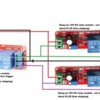I'm in need of some electrical genius help. I have a semaphore from overseas that i want to install on my layout. The semaphore changes aspects based on a short pulse of power (ie, not like my Tortoise switch machines that just get a steady supply and polarity determines which have a limit/stall out motor). There are 2 wires to be pulsed, but never at the same time. One switches the semaphore to block-occupied aspect, the other wire will switch the semaphore to a block-clear aspect. (Thus both can never be connected at the same time).
SO, at first i thought to make 2 cuts close together in the track near the middle of the block so that as the train crosses, it activates the block occupied... which is safe only as long as a train does not stop on this very short contact section. But this does not address how the signal can ever get reset. I'm trying to avoid the very bulky train infrared train detectors. I have some of those from MTH and they're just huge and prone to mishaps in well-lit rooms. Anyone have some ideas how I can get a temporary pulse to the semaphore so it throws the correct aspect for occupied/unoccupied track block?









